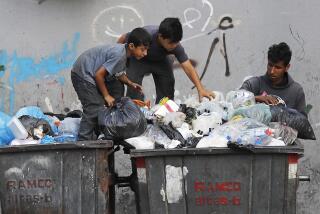Grim Survival in India : Child Ragpickers Scrounge Out a Living
- Share via
NEW DELHI — Every day, 12-year-old Shashi Bushan Das starts out at dawn with a burlap sack over his bony shoulder. At the end of the day, the sack is bulging with trash--and if he’s lucky he has earned the equivalent of $1.
Shashi is a ragpicker, one of the tens of thousands of children in New Delhi who scrounge through garbage bins, gutters and waste dumps.
Trash dealers buy what they find--paper, plastic shopping bags, parts of automobiles, and pieces of brass and tin.
The children start at 5 a.m. and work in pairs until noon, when they stop for their first meal of the day.
A survey published by Praveen Nangia, a social scientist and expert on child labor, said 80% of these children live alone and sleep on sidewalks in the summer and in government-run shelters during the winter.
“By the time these children, who are aged between 5 and 15, reach the junk dealer their sacks weigh nearly 10 to 15 kilograms (22 to 33 pounds),” the survey said.
Dreary as it may seem, ragpicking is one of the more lucrative forms of child labor in India today. An expert picker may earn up to $1 a day. The daily per capita income of India is 66 cents.
“There is lot of money in garbage,” said Gerry J. Pinto of the U.N. International Children’s Emergency Fund (UNICEF), who works on the organization’s program for destitute children in India.
Ragpicking pays more than any other form of child labor in India where every third child works, said Vidyaben Shah, president of the Indian Council for Child Welfare, a voluntary organization with offices in each of India’s 25 states.
No official estimates are available on the number of ragpickers in India. Pinto puts the figure at 50,000, but adds he could be way off the mark.
Pinto said that although a law regulates working conditions for child laborers in most industries, none covers ragpickers, “who are doing a very legitimate service to the city.”
Most Are Runaways
“Most of these children are runaways, forced to flee homes in villages because of poverty or family breakups and now fighting for survival in the towns,” he said.
“Ragpicking is the easiest thing to do when a child lands in the city. You don’t need any skills, you don’t need licenses and you can go into business directly after getting down from the bus or train.”
Shashi operates in areas around the railroad station, which was the first landmark he saw on arriving eight months ago.
Shashi said he ran away from his remote village in the eastern state of Bihar after he got into an altercation with his schoolmaster.
“He deliberately failed me in exams even though I had studied well. And then my father beat me up so I ran away,” Shashi said.
“These children poke their hands in garbage dumps where dirty pigs and dogs nuzzle for food. They live in garbage, sleep in garbage and wake up in garbage,” said Shah, who has worked with street children for the last 30 years.
Nangia’s survey, taken from interviews with children from six areas of the city, indicated that none of them wants to be in the business forever.
Shashi already is planning something else.
“In six months, I will save money to buy a cart,” he said. “Then I will sell peanuts and cucumbers.”
More to Read
Sign up for Essential California
The most important California stories and recommendations in your inbox every morning.
You may occasionally receive promotional content from the Los Angeles Times.










